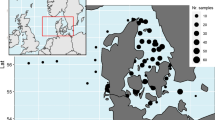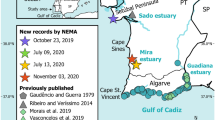Abstract
Estimates of propagule pressure in invasion biology are often unavailable due to widespread use of proxy variables, leading to uncertainty in absolute introduction effort of marine non-indigenous species (NIS). We present a first estimate of absolute propagule pressure (probability distributions of the total number of individuals introduced per release event and per year) for viable non-indigenous dinoflagellates transported via commercial vessels to major ports on the East and West coasts of Canada, thereby establishing a baseline metric against which to test future hypotheses about factors controlling invasion rates. To quantify the influence of ballast water management on absolute propagule pressure, three shipping routes were evaluated: (1) transoceanic with mandatory ballast water exchange (BWE), (2) coastal with BWE, and (3) coastal without BWE. Results provide insufficient evidence that BWE consistently reduces propagule pressure of dinoflagellates in ballast tanks. Moreover, controlled growth experiments confirmed that several dinoflagellate species were viable (e.g., capable to reproduce) following their release from arriving vessels, including those conducting exchange. We caution that the ecological significance of these findings is unclear without a better understanding of the factors that allow offshore dinoflagellates to establish in nearshore marine environments; however, several dinoflagellates NIS may have the potential to become established in Canadian coastal marine ecosystems following ballast water exchange.

Similar content being viewed by others
References
Adams JK, Ellis SM, Chan FT, Bronnenhuber JE, Simard N, McKenzie CH, Martin JL, Bailey SA (2014) Relative risk assessment for ship-mediated introductions of aquatic nonindigenous species to the Atlantic Region of Canada. DFO Canadian Science Advisory Secretariat Research Document 2012/116, p 403
Andersen P, Throndsen J (2004) Estimating cell numbers. In: Hallegraeff GM, Anderson DM, Cembella AD (eds) Manual on harmful marine Microalgae., Monographs on oceanographic methodology no. 11UNESCO Publishing, Paris, pp 99–130
Anderson DM, Kulis DM, Doucette GJ, Gallager JC, Balech E (1994) Biogeography of toxic dinoflagellates in the genus Alexandrium from the northeast United Stats and Canada as determined by morphology, bioluminescence, toxin composition, and mating compatibility. Mar Biol 120:467–478
Anderson DM, Alpermann TJ, Cembella AD, Collos Y, Masseret E, Montresor M (2012) The globally distributed genus Alexandrium: multifaceted roles in marine ecosystems and impacts on human health. Harmful Algae 14:10–35
Bailey SA (2015) An overview of thirty years of research on ballast water as a vector for aquatic invasive species to freshwater and marine environments. Aquat Ecosyst Health Manag 18:261–268
Bailey SA, Deneau MG, Jean L, Wiley CJ, Leung B, MacIsaac HJ (2011) Evaluating efficacy of an environmental policy to prevent biological invasions. Environ Sci Technol 45:2554–2561
Bérard-Therriault L, Poulin M, Bossé L (1999) Guide d’identification du phytoplancton marin de l’estuaire et du golfe du Saint-Laurent. Publication spéciale canadienne des sciences halieutiques et aquatiques, no 128, p 387
Berghe EV (2007) The ocean biogreographic information system. http://www.iobis.org. Accessed 5 May 2016
Blackburn TM, Pysek P, Bacher S, Carlton JT, Duncan RP, Jarosik V, Wilson JRU, Richardson DM (2011) A proposed unified framework for biological invasions. Trends Ecol Evol 7:333–339
Briski E, Bailey SA, Casas-Monroy O, DiBacco C, Kaczmarska I, Levings C, MacGillivary ML, McKindsey CW, Nasmith LE, Parenteau M, Piercey GE, Rochon A, Roy S, Simard N, Villac C, Weise AM, MacIsaac HJ (2012) Relationship between propagule pressure and colonization pressure in invasion ecology: a test with ships’ ballast. Proc R Soc B Biol Sci 279:2990–2997. doi:10.1098/rspb.2011.2671
Briski E, Bailey SA, Casas-Monroy O, DiBacco C, Kaczmarska I, Lawrence JE, Leichsenring J, Levings C, MacGillivary ML, McKindsey CW, Nasmith LE, Parenteau M, Piercey GE, Rivkin RB, Rochon A, Roy S, Simard N, Sun B, Way C, Weise AM, MacIsaac HJ (2013) Taxon- and vector-specific variation in species richness and abundance during the transport stage of biological invasions. Limnol Oceanogr 58(4):1361–1372. doi:10.4319/lo.2013.58.4.1361
Carlton JT (1985) Transoceanic and interoceanic dispersal of coastal marine organisms: the biology of ballast water. Oceanogr Mar Biol Annu Rev 23:313–371
Casas-Monroy O, Roy S, Rochon A (2012) Dinoflagellate cysts in ballast sediments: differences between Canada’s east coast, west coast and the Great Lakes. Aquat Conserv Mar Fresh Ecosyst. doi:10.1002/aqc.2310
Casas-Monroy O, Linley RD, Adams JK, Chan FT, Drake DAR, and Bailey SA (2014) National risk assessment for introduction of aquatic nonindigenous species to Canada by ballast water. DFO Canadian Science Advisory Secretariat Research Document 2013/128, p 57
Casas-Monroy O, Linley RD, Adams JK, Chan FT, Drake DAR, Bailey SA (2015) Relative invasion risk for plankton across marine and freshwater systems: examining efficacy of proposed international ballast water management. Plos one. doi:10.1371/journal.pone.0118267
Clarke KR, Warwick RM (1994) Similarity-based testing for community pattern: the two-way layout with no replication. Mar Biol 118:167–176
Colautti RI, MacIsaac HJ (2004) A neutral terminology to define ‘invasive’ species. Divers Distrib 10:135–141
Dodge JD (1982) Marine dinoflagellates of the British Isles. Her Majesty’s Stationery Office, London, pp 1–303
Drake DAR, Casas-Monroy O, Koops MA, Bailey SA (2015) Propagule pressure in the presence of uncertainty: extending the utility of proxy variables with hierarchical models. Methods Ecol Evol 6:1363–1371
Duncan RP, Blackburn TM, Rossinelli S, Bacher S (2014) Quantifying invasion risk: the relationship between establishment probability and founding population size. Methods Ecol Evol. doi:10.1111/2041-210X.12288
GBIF (2016) GBIF information update—[May 2016]. Copenhagen: global biodiversity information facility. http://www.gbif.org/resource/81772
Gomez F (2012) A checklist and classification of living dinoflagellates (Dinoflagellata, Alveolata). CICIMAR Oceánides 27:56–140
Grosholz ED, Ruiz GM (1996) Predicting the impact of introduced marine species: lessons from the multiple invasions of the European Green Crab Carcinus maenas. Biol Conserv 78:59–66
Guillard RRL (1975) Culture of phytoplankton for feeding marine invertebrates. In: Smith WL, Chanley MH (eds) Culture of marine invertebrate animals. Plenum Press, New York, pp 26–60
Hallegraeff GM (2002) Aquaculturists’ guide to harmful Australian microalgae. School of Plant Science. University of Tasmania, Hobart 136 pp
Horiguchi T, Yoshizawa-Ebata J, Nakayama T (2000) Halostylodinium arenarium, Gen et Sp. Nov. (Dinophyceae), a coccoid sand-dwelling dinoflagellate from subtropical Japan. J Phycol 36:960–971. doi:10.1046/j.1529-8817.2000.00007.x
John U, Litaker RW, Montresor M, Murray S, Brosnahan ML, Anderson DM (2014) Formal revision of the Alexandrium tamarense species complex (Dinophyceae) taxonomy: the introduction of five species with emphasis on molecular-based (rDNA) classification. Protist 165:779–804
Klein G, MacIntosh K, Kaczmarska I, Ehrman JM (2010) Diatom survivorship in ballast water during trans-Pacific crossings. Biol Invasions 12:1031–1044. doi:10.1007/s10530-009-95206
Lawrence DJ, Cordell JR (2010) Relative contributions of domestic and foreign sourced ballast water to propagule pressure in Puget Sound, Washington. USA. Biol Conserv 143(3):700–709. doi:10.1016/j.biocon.2009.12.008
Li A, Stoecker DK, Coats DW, Adam EJ (1996) Ingestion of fluorescently labeled and phycoerythrin-containing prey by mixotrophic dinoflagellates. Aquat Microb Ecol 10:139–147
Linley RD, Doolittle AG, Chan FT, O’Neill J, Sutherland T, Bailey SA (2013) Relative risk assessment for ship-mediated introductions of aquatic nonindigenous species to the Pacific Region of Canada. DFO Canadian Science Advisory Secretariat Research Document 2012/043, p 165
Lockwood JL, Hoopes MF, Marchetti MP (2007) Invasion Ecology. Blackwell Publishing, Oxford
Lockwood JL, Cassey P, Blackburn TM (2009) The more you introduce the more you get: the role of colonization pressure and propagule pressure in invasion ecology. Divers Distrib 15:904–910
Martin JL, LeGresley MM (2008) New phytoplankton species in the Bay of Fundy since 1995. ICES J Mar Sci 65(5):759–764
McArdle BH, Anderson MJ (2001) Fitting multivariate models to community data: a comment on distance-based redundancy analysis. Ecology 82:290–297
Mills E, Leach JH, Carlton JT, Secor CL (1993) Exotic species in the Great Lakes: a history of biotic crises and anthropogenic introductions. J Great Lakes Res 19(1):1–54
Popa L (2009) Marine bio pollution through ballast water. Mar Transp Nav J 1(1):105–109
Rigby G, Hallegraeff GM (1994) The transfer and control of harmful marine organisms in shipping ballast water: behaviour of marine plankton and ballast water exchange trials on the MV “Iron Whyalla”. J Mar Environ Eng 1:91–110
Roy S, Parenteau M, Casas-Monroy O, Rochon A (2012) Coastal ship traffic: a significant introduction vector for potentially harmful dinoflagellates in eastern Canada. Can J Fish Aquat Sci 69:627–644
Ruiz GM, Reid DF (2007) Current state of understanding about the effectiveness of ballast water exchange (BWE) in reducing aquatic nonindigenous species (ANS) introductions to the Great Lakes and Chesapeake Bay, USA: synthesis and analysis of existing information. NOAA Technical Memorandum GLERL-142
Seebens H, Gastner MT, Blasius B (2013) The risk of marine bioinvasion caused by global shipping. Ecol Lett 16:782–790
Seiden JM, Way C, Rivkin RB (2011) Bacterial dynamics in ballast water during trans-oceanic voyages of bulk carriers: environmental controls. Mar Ecol Progr Ser 436:145–159. doi:10.3354/meps09231
Simard N, Plourde S, Gilbert M, Gollash S (2011) Net efficacy of open ocean ballast water exchange on plankton communities. J Plankton Res 33(9):1378–1395
Sinclair JS, Arnott SE (2016) Strength in size not numbers: propagule size more important than number in sexually reproducing populations. Biol Invasions 18(2):497–505
Skovgaard A (2000) A phagotrophically derivable growth factor in the plastidic dinoflagellate Gyrodinium resplendens (Dinophyceae). J Phycol 36:1069–1078
Smith LD, Wonham M, McCann L (1999) Invasion pressure to a ballast-flooded estuary and an assessment of inoculant survival. Biol Invasions 1:67–87
Steichen JL, Schulze A, Brinkmeyer R, Quigg A (2014) All aboard! A biological survey of ballast water onboard vessels spanning the North Atlantic Ocean. Mar Poll Bull 87:201–210
Steidinger KA, Tangen K (1996) Dinoflagellates. In: Tomas C (ed) Identifying marine diatoms and dinoflagellates. Academic Press Inc, Cambridge, pp 387–570
Taylor FJR, Waters RE (1982) Spring phytoplankton in the subarctic North Pacific Ocean. Mar Biol 67:323–335
Taylor FJR, Fukuyo Y, Larsen J, Hallegraeff GM (2003) Taxonomy of harmful dinoflagellates. In: Hallegraeff GM, Anderson DM, Cembella AD (eds) Manual on harmful marine Microalgae., Monographs on oceanographic methodology 11UNESCO Publishing, Paris, pp 389–432
Terlizzi A, Benedetti-Cecchi L, Belilacqua S, Fraschetti S, Guidetti F, Anderson MJ (2005) Multivariate and univariate asymmetrical analyses in environmental impact assessment: a case study of Mediterranean subtidal sessile assemblages. Mar Ecol Prog Ser 289:27–42
Transport Canada (2012) Canadian implementation of the ballast water convention. http://www.tc.gc.ca/media/documents/marinesafety/Canada_Ballast_Water_Implementation_Discussion_Paper_Revised.pdf. Accessed 16 July 2013
United States Coast Guard [USCG] (1993) Ballast water management for vessels entering the Great Lakes. 33-CFR Part 151.2010/151.2041
Utermöhl H (1958) Zur Vervollkommnung der quantitativen Phytoplankton-Methodik. Mitteilung/Internationale Verein Theor Angew Limnol 9:1–38
Williamson MH (1996) Biological invasions. Chapman & Hall, London
Wonham MJ, Walton W, Ruiz GM, Frese AM, Galil BS (2001) Going to the source: role of the invasion pathway in determining potential invaders. Mar Ecol Progr Ser 215:1–12
Wonham MJ, Byers JE, Grosholz ED, Leung B (2013) Modeling the relationship between propagule pressure and invasion risk to inform policy and management. Ecol Appl 23:1691–1706
Acknowledgments
We thank shipping companies, crews, and port authorities whose support facilitated the sampling of ballast tanks. We are grateful to the sampling teams on both coasts and to Sylvie Lessard for taxonomic assistance. Finally, we thank Editor and reviewers for insightful discussion and comments that improved the manuscript.
Funding
Funding for this study was provided by the Natural Sciences and Engineering Research Council of Canada (NSERC), the Canadian aquatic Invasive species Network (CAISN), Fisheries and Oceans Canada (DFO), Québec-Océan, and the Institut de sciences de la mer de Rimouski (ISMER)—Université du Québec à Rimouski.
Author information
Authors and Affiliations
Corresponding author
Ethics declarations
Conflict of interest
The authors have declared that no competing interests exist.
Ethical approval
This article does not contain any studies with human participants or animals performed by any of the authors.
Additional information
Responsible Editor: E. Briski.
Reviewed by G. M. Hallegraeff and an undisclosed expert.
This article is part of the Topical Collection on Invasive Species.
Electronic supplementary material
Below is the link to the electronic supplementary material.
Rights and permissions
About this article
Cite this article
Casas-Monroy, O., Parenteau, M., Drake, D.A.R. et al. Absolute estimates of the propagule pressure of viable dinoflagellates across Canadian coasts: the variable influence of ballast water exchange. Mar Biol 163, 174 (2016). https://doi.org/10.1007/s00227-016-2946-3
Received:
Accepted:
Published:
DOI: https://doi.org/10.1007/s00227-016-2946-3




